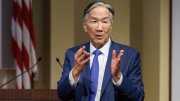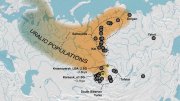Across the United States, a chronic housing shortage grips many large metropolitan areas. Low inventories have driven prices sharply higher, making homes unaffordable for many young families and low- and middle-income workers. Jacob Anbinder, a doctoral student in history, says the current crisis has been decades in the making—and argues that its origins lie in the rise of “antigrowth politics” that began to take hold in the Democratic Party in the 1950s.
Anbinder came to Harvard to study urban history, but it was firsthand experience with the exorbitant cost of living in New York and Greater Boston that got him interested in exploring why, for instance, a two-bedroom row house in New York City’s Greenwich Village that cost $7,000 in 1947 is today worth more than $6 million: a nearly thousand-fold increase in value. Average consumer prices, by contrast, rose just 13 times during this period.
The ideological shifts driving this extraordinary rise in urban home values are explored in “Cities of Amber: Antigrowth Politics and the Making of Modern Liberalism, 1950-2008,”Anbinder’s dissertation in progress. In the years following World War II, he says, Democrats were “emphatically supportive of urban growth.” This was the party of labor unions and blue-collar workers, who were the backbone of the cities that now comprise the party’s political base. But then growth came to be seen as a threat to the stability of city-dwellers’ quality of life. Anbinder set out to understand why so many American cities stopped building housing—and “why my neighbors in Cambridge, all liberal Democrats, seem to be opposed to measures that would make housing more affordable.”
Key to his analysis is a conviction that this opposition is not driven principally by cynical self-interest (such as NIMBYism—Not-In-My-Backyard politics), but by ideology, so that “people in their heart of hearts believe that it is consistent with their identities as liberals to oppose housing. What were the changes that took place in American liberalism,” he asks, “particularly as it is practiced at the local level, that led them to come to conclusions about whether new housing was good or bad?”
In cities, he argues, the historic-preservation movement was one avenue for the expression of these shifting priorities. “Overwhelmingly, the focus of the preservation movement before World War II was on protecting buildings of great historical importance. A significant broadening of the criteria for what ought to be preserved,” he says, occurred in the postwar period; suddenly it was “seen as legitimate to protect entire neighborhoods and buildings because they happened to represent a particular period of architecture.” Behind this opposition was a desire to “preserve things people believed were beautiful, and stop horrible-looking, monotonous development that they considered ugly,” articulating convictions “that a lot of people felt deeply.” Anbinder, whose great-aunt and grandfather were deeply involved in historic preservation in New York, doesn’t necessarily disagree with these assessments. But “Notably,” he adds, “those cities were not experiencing the cost-of-living crises that they are today.”
In the suburbs and beyond, even among Republicans, open-space protections played a similar role. Legitimate environmental considerations such as aquifer and habitat protection defined the earliest aspects of the movement as former fields and forests gave way to highways, subdivisions, and sprawling malls. Later, anti-growth politics evolved as part of cultural notions about where a city’s food should come from (locally, as part of the “slow food” and “farm to table movements,” for example). These trends, he says, began to “inform liberal ideas of the ideal metropolis” and how people who live in cities and suburbs should relate to the things they eat—including where and how food is grown and transported to cities. “Even when people don’t perceive it themselves,” Anbinder continues, “the desire to use produce that comes from the Hudson River Valley, for instance, or from Sonoma, begins to shape people’s ideas of how cities should or should not grow.”
At its extreme, he contends, the open-space movement led to growth-control plans such as those (upheld by the courts) in places like Petaluma, California, and Ramapo, New York, where new development can take place only in lockstep with public infrastructure growth, its cost often shifted onto the developers themselves.
The changing class composition of the Democratic Party, says Anbinder, is an important aspect of this late-twentieth-century realignment of liberal priorities. “As surburbanites moved into the party, it became much more white-collar, much better educated, and much less labor-focused.” This prosperous cohort began to express in the 1960s and 1970s the concern that the country’s growth had begun to erode quality of life. “That’s the kind of liberalism that I’m writing about,” he says. “It’s an interest in preserving, rather than creating, that becomes an animating force” behind progressive politics. “That’s the story of how we get to liberal opposition to new housing—through this changing set of priorities that emphasize protection of the environment and historic preservation and other issues, over the creation of new housing, and the need to ensure continued upward mobility for all Americans.”









